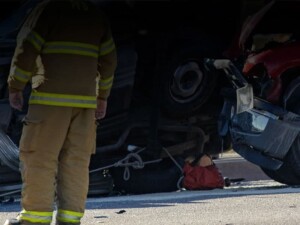-

Many young drivers are ill-prepared for the challenges of independent driving – but parents can help.
Teenage drivers have it harder
Young drivers, a demographic including adolescents and young adults aged 15 to 20, constitute 5.4 percent of all licensed drivers in the US. This means that there are some 11.8 million teenagers ready to hit the road.∗ And many of them will do so, and often, in the months to come. With summer vacations in full swing, youths have more time on their hands and many of them will spend a considerable amount of behind the wheel. Some will drive just for fun, others will commute each day for their summer jobs. Many of those young drivers will probably be getting their first car this year. Some lucky teens may receive a car as a graduation gift from a parent or grandparent but many will make this purchase on their own and chances are that what a teenager will be able to afford will be an older or badly maintained vehicle. For teenagers, having a car can be the first step into the world of independence and adulthood and parents have a role to play in teaching their child basic driving safety and responsibilities as well as vehicle maintenance and repairs because the sad truth is that each year, more teens die in car crashes than from any other cause. Part of the reason being that young drivers are far more likely than adult drivers to engage in risky behaviors, such as driving while intoxicated or driving while distracted.Established consensus in the scientific community says that this is because, in a teenage brain, areas responsible for control, planning, and reasoning are not fully mature yet. Thus, parental control and support will play a crucial role in helping a young driver to stay safe during this summer as well as all year round. But what exactly parents should teach their children when it comes to car safety? This article will present some practical points and ideas.
Be a good role model
Most often than not, a child’s first exposure to driving a car comes from the rides they take with their parents; thus, a teenager will probably end up unwittingly imitating their mother’s or father’s driving style. It is therefore very important that parents strive to be good examples of responsible drivers. This primarily involves displaying safe driving habits and avoiding risky behaviors. What should parents be particularly wary of? According to the Center for Disease Control and Prevention (CDC), teens have the lowest rates of seatbelt use among all age groups; the agency also points out that in 2014, more than a third of male drivers aged 15-20 involved in fatal accidents were speeding at the time of the crash. Moreover, National Highway Traffic Safety Administration (NHTSA) also states that teenagers are the group most likely to be involved in a fatal crash due to distracted driving. The message for parents of teenage drivers should be clear – talk with your children about those behaviors regularly and never display any risky driving habits yourself. In addition, both the CDC and the American Automobile Association (AAA) advise parents to draft a parent-teen driving agreement. Such a document may outline both a teenager’s driving privileges and limitations, detail behaviors that are strictly prohibited, and describe consequences for breaching the contract in any way. Sample agreements can be bothAAA’s and CDC’s websites. It is worth noting that teenagers who are involved in the process of drafting the agreement by being allowed to weigh in on the rules are more likely to follow them.
Open the hood together
 Although adhering to traffic rules and avoiding risky driving behaviors are of utmost importance, being a mature user of the road involves more than that. Since poor car maintenance can lead to a collision parents should also teach their children other vital skills related to basic car maintenance and repairs. But how exactly? Parents shouldn’t shy away from opening the hood and teaching young drivers how to identify the basic parts of the engine, like the oil filter, the battery, and the spark plugs. Young drivers should also know what to look for, or more precisely, what to listen for in a car. Parents would do well to explain to a young driver that sounds coming out of various parts of the car can be a vital way to identify potential problems and defects. A simple example – if a car does not start, it may be a starter issue or a dead battery; the two issues,however, produce distinctly different sounds and it is helpful to know the difference. Also, a teenage car owner should know how a healthy engine sounds and what noises it may make when something goes awry. Even if they do not end up doing the repairs themselves, that knowledge will likely allow them to notice issues before they become critical, thus sparing a young driver the cost of a more extensive repair. Other practical skills a teenage driver should master are:
Although adhering to traffic rules and avoiding risky driving behaviors are of utmost importance, being a mature user of the road involves more than that. Since poor car maintenance can lead to a collision parents should also teach their children other vital skills related to basic car maintenance and repairs. But how exactly? Parents shouldn’t shy away from opening the hood and teaching young drivers how to identify the basic parts of the engine, like the oil filter, the battery, and the spark plugs. Young drivers should also know what to look for, or more precisely, what to listen for in a car. Parents would do well to explain to a young driver that sounds coming out of various parts of the car can be a vital way to identify potential problems and defects. A simple example – if a car does not start, it may be a starter issue or a dead battery; the two issues,however, produce distinctly different sounds and it is helpful to know the difference. Also, a teenage car owner should know how a healthy engine sounds and what noises it may make when something goes awry. Even if they do not end up doing the repairs themselves, that knowledge will likely allow them to notice issues before they become critical, thus sparing a young driver the cost of a more extensive repair. Other practical skills a teenage driver should master are:- read different car dashboard warning lights – this is another way of ensuring that problems are identified before they become severe
- check fluid levels – a teenager should be able to not only locate, for example, the oil dipstick but also know to park the car on level ground and wait about an hour for the engine to cool down before performing the test
- check tire pressure – apart from being a maintenance issue, it is also a safety one; for example, according to a study performed by NHTSA, vehicles with tires underinflated by 25% are three times more likely to be involved in a tire-related crash; a young driver should know different factors that affect tire pressure, such as temperature or driving distance, how to use a tire pressure gauge, and how to respond to different pressure readings
- change the oil – this procedure significantly prolongs the engine’s lifetime and should be performed every 3,000 – 5,000 thousand miles. Young drivers should be taught to keep track of when their last oil change was, and know when to either make an appointment for their next one or learn to change the oil themselves.
- change a tire – it is not too difficult to imagine a scenario where a young driver gets stranded on the side of the road with a flat tire, a dead battery in their mobile phone, and no means to call road service – in such a situation being able to change a tire is an essential skill
When the moment comes that a teenager is old enough and qualified enough to obtain their full driver’s license, parents may panic at the thought of their child navigating traffic-packed streets alone. Therefore, in the years leading up to that moment, parents should do all they can to ensure that when their child finally becomes an independent driver, they will drive safely, responsibly and will have the skills to tackle unexpected situations with maturity. It can be hoped that thanks to the efforts of the parents of teenage drivers, American roads will become safer for everyone.∗NHTSA Traffic Safety Facts, Young Drivers, Data for 2015
Get In Touch Today!
We offer free consultations 24/7 and there will always be someone here to take your call. Call our personal injury lawyers today for a free consultation or fill out this form and we will contact you.
We serve clients across Tennessee and Kentucky and we have several offices throughout both states. See all of our locations and contact us today.



 Although adhering to traffic rules and avoiding risky driving behaviors are of utmost importance, being a mature user of the road involves more than that. Since
Although adhering to traffic rules and avoiding risky driving behaviors are of utmost importance, being a mature user of the road involves more than that. Since